- NLI Research Institute >
- Economy to Pick Up in Early Autumn and Post 1.6% Growth for the Year -Revised Economic Forecast for Fiscal 1997
Economy to Pick Up in Early Autumn and Post 1.6% Growth for the Year -Revised Economic Forecast for Fiscal 1997
the Economic Research Dept.
Font size
- S
- M
- L
The economy’s present standstill comes primarily as a result of the consumption slump following April’s consumption tax hike. However, steady capital investment and solid foreign demand are mitigating the impact of this decline, enabling the economy to pick up speed. Our revised forecast raises fiscal 1997’s real GDP growth to 1.6 percent from 1.4 percent in our previous forecast released on April 1.
1. Domestic Economy
(1) Present Status
In the second half of fiscal 1996, the economy showed signs of picking up. Private demand recovered as automobile sales growth accelerated and capital investment continued to expand, while the weaker yen stimulated external demand. Helped also by the last-minute demand rush in the January-March 1997 quarter, both final demand and production posted strong growth.
However, the economy came to a standstill as housing starts fell after peaking in October 1996, private final demand slumped primarily from a substantial drop in automobile and large-scale retail store sales, and industrial production leveled off. The present economic standstill is the third in a recovery that began in October 1993, following the slumps caused by the ultra-strong yen in the first half of fiscal 1995, and the inventory mini-adjustment in the first half of fiscal 1996.
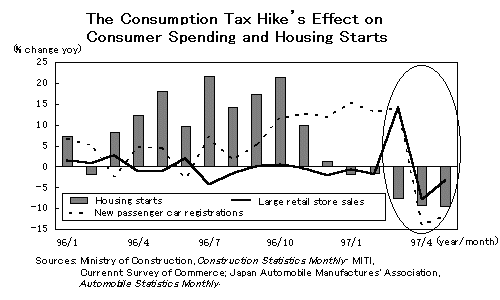
(2) Japan’s Economy in Fiscal 1997
Though the recovery remains weak and structural problems linger, the economy will pick up as the following factors counteract the impact of the consumption slump and fiscal tightening measures: (1) continued growth in capital investment; (2) continued positive contribution of external demand to GDP growth; and (3) rising employment and other improvements in the income environment. Although fiscal 1997’s real GDP growth will edge down from the previous year to 1.6 percent, the economy’s underlying recovery trend will continue.
1) Forecast Assumptions
- Public spending: no additional spending packages.
- Exchange rate (annual average): $1=¥112
- Oil price (customs clearance): $19/barrel
- Official discount rate: 0.5% hike in the Jan-Mar 1998 quarter.
2) Key Points of the ForecastThe economy’s standstill in the first half of fiscal 1997 can be attributed to reduced fiscal spending, combined with a slump in private sector demand from: (1) the reactive decline in consumption following the consumption tax hike; (2) higher tax burden on households from the consumption tax hike and abolition of the special income tax cut.
The revised forecast incorporates two changes that exceeded our predictions: (1) a larger last-minute demand rush, and (2) faster growth in external demand. Other than this, our forecast basically remains unchanged. Whether the economy will resume its recovery depends on a sustainable recovery in private demand (particularly consumption and capital investment), and on growth in external demand, which has been supporting the economy.
Since the downward revisions in consumption and housing are more than offset by upward revisions in external demand and other areas, we revised our predicted real GDP growth rate slightly upward to 1.6 percent (1.4 percent in the previous forecast).
Impact of Higher Tax Burden on Households
The last-minute demand surge in the January-March quarter exceeded our prediction. Since the surge indicates that demand was shifted forward, it indicates that negative factor in fiscal 1997 ;has increased. The reactive decline will be greatest in the April-June quarter, and fade out from the July-September quarter onward.
The additional tax burden on households from the abolished special income tax and consumption tax hike is estimated at approximately 8 trillion yen (fiscal 1997). This will reduce real disposable income and hence consumption. However, employment is improving due to recovering corporate performance. While the reactive decline in consumption will have depressed private consumption in the April-June quarter, it will recover moderately from the July-September quarter as incomes improve and alleviate the household tax burden.
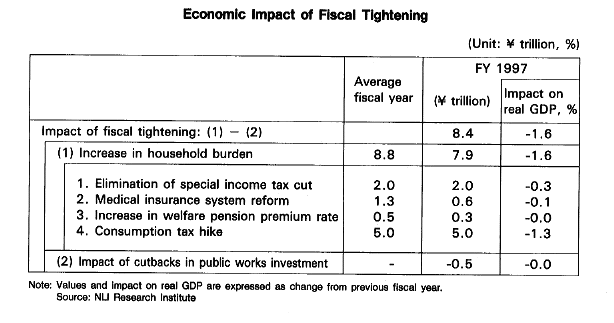
Capital Investment
Capital investment growth in fiscal 1996 rose to 6.4 percent, outpacing the previous year’s growth of 5.7 percent on the strength of independent investment in the communications sector as well as the widening scope of investment activity from large manufacturers to non-manufacturing and smaller companies.
In fiscal 1997, there is potential for continued growth due to (1) the recovery in corporate performance, and (2) progress in capital stock adjustment. Corporate profit ratios have recovered to average historical levels against a backdrop of the weaker yen. Moreover, returns on investment have maintained an improvement trend against a backdrop of low interest rates. From a cyclical viewpoint, capital investment will continue to grow in fiscal 1997.
However, various surveys of investment plans for fiscal 1997 show that no sector will lead investment as communications did in fiscal 1996. Furthermore, excluding large manufacturers, the recovery in returns on investment has relied heavily on low interest rates. With interest rates expected to rise moderately, capital investment growth in fiscal 1997 will be lower than in fiscal 1996.
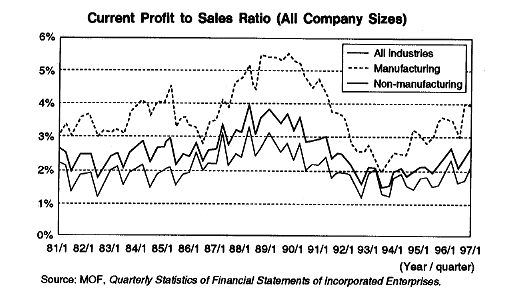
External Balance
The current surplus has been growing after it bottomed out in the April-June 1996 quarter. This can be attributed to (1) the sustained weakening yen exceeding export profitability and (2) expanding foreign economies, particularly the U.S., causing exports to recover. The surplus increased in the April-June 1997 quarter as slumping domestic demand caused imports to slow, while manufacturers shifted their emphasis to exports.
As of June 1997, the yen had returned to the 110-yen range after peaking at 127 yen in early May. The exchange rate we have assumed for the forecast exceeds the breakeven exchange rate of exporters (106 yen, according to a January 1997 EPA survey) and will work to expand the surplus. The surplus will continue to grow despite higher imports expected from the growing international division of labor in manufacturing. The current surplus in fiscal 1997 will grow to 10.4 trillion yen (2 percent of nominal GDP). The contribution of external demand to GDP growth will turn positive for the first time in five years.
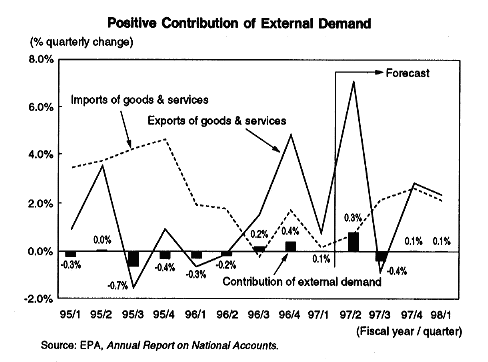
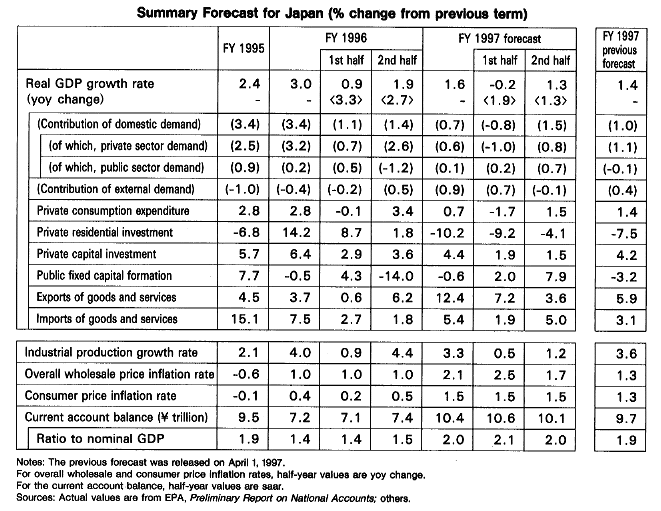
2. Monetary Policy and Interest Rates − Interest Rate Hike Expected in January-March 1998
(1) Present Status
Since September 1995, when the official discount rate was cut and the unsecured call rate was induced downward, these rates have remain unchanged for approximately two years. The long-term interest rate drifted downward from August 1996 until April 1997, when the yield on government bonds with the longest maturity reached a record low in the 2.2 percent range.
The long-term interest rate then rose sharply due to (1) a decline in pessimism and (2) reevaluation of the ultra-low interest policy. Interest rates edged down recently as weak economic indicators and the strong yen reduced upward pressure on interest rates, but began rising again after the BOJ Tankan Survey on June 25 showed an improvement in the diffusion index. The present long-term interest rate is approximately at the level it was in the October-December 1996 quarter.
Stock prices have also recovered somewhat as pessimism has declined.
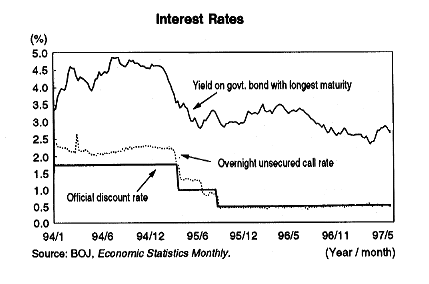
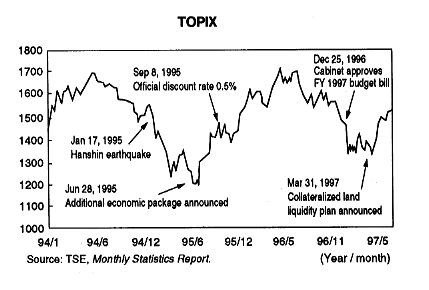
(2) Interest Rates to Rise
Monetary policy will maintain a basic stance of low interest rates due to the weakness of the economic recovery, restrained fiscal spending, the nonperforming loan disposal problem and corporate balance sheet problems.
Monetary policy has two options available. The first is to maintain ultra-low interest rates over the long term until the economy accelerates and inflationary concerns arise, at which time a series of rate hikes will be implemented as a preventive measure, as the U.S. did in 1994. Second, to implement small rate hikes intermittently even though inflation is not a concern at present and the economy is in the process of shifting to dependence on private sector demand.
We predict that the latter option will be taken−from the summer of 1997, upon confirmation that the economy has picked up in a sustainable manner, the discount rate will be increased from the present 0.5 percent to 1.0 percent, most likely in the January-March 1998 quarter. This will bring an end to the ultra-low interest rate policy.
The NLI Research interest rate leading indexes have recently been low, and have not signaled a series of rate hikes (Index I must climb to 80 percent for at least three consecutive months).Thus the rate hike predicted in the January-March 1998 quarter should be a single move.
The long-term interest rate will tend to rise under the influence of rising short-term rates, but the rise will be limited by four factors: (1) the increase in short-term rates will be moderate; (2) supply and demand will be tight; (3) the yen will appreciate moderately; and (4) U.S. interest rates will peak out.
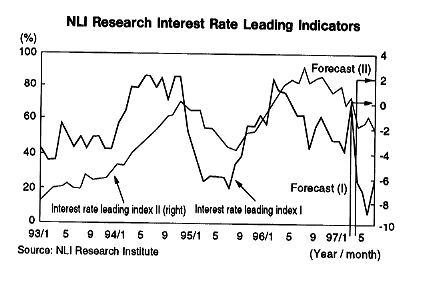
3. Exchange Rate
(1) Present Status − Sharp Correction of the Weak Yen
In mid December 1996, the dollar began to surge against the yen amid a perception of growing disparities between Japanese and U.S. economic conditions and interest rates. After the yen fell to 127 yen against the dollar in early May, it underwent a sharp correction due to efforts by Japanese monetary authorities to talk up the yen, improving sentiment regarding the Japanese economy (rebound in stock prices, etc.), slowdown of the U.S. economy and postponement of an interest rate hike, and concern by U.S. monetary authorities regarding Japan’s growing external surplus. However, further appreciation appears limited, as monetary authorities have stated that the yen is overvalued in the 110-115 range.
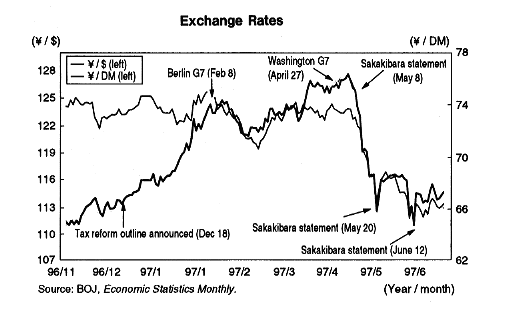
(2) Yen Expected to Appreciate Moderately
The yen should remain in the 110-120 yen range through the end of the first half of fiscal 1997. The weak yen phase that began in April 1995 and lasted approximately two years has ended, and the yen has shifted to a moderate appreciation phase. The yen should move into the 100-105 range by the end of fiscal 1997. We have revised our predicted average exchange rate for fiscal 1997 from 114 yen to 112 yen based on the following factors.
1. Japan's Large Current Account SurplusThe four yen appreciation phases since 1971 have occurred against a backdrop of growing current surpluses. In the present case, while the expanding surplus is expected to strengthen the yen, the surplus's relatively small size suggests that the pace of appreciation will be moderate.
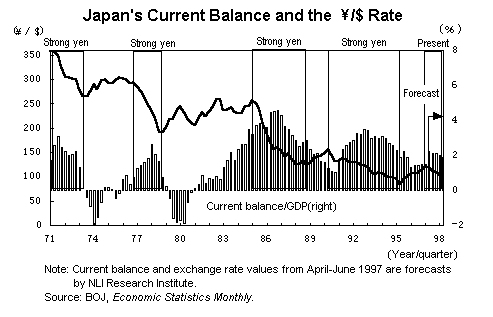
2. U.S./Japan Disparities in Economic Conditions and Interest RatesInterest rate differentials between Japan and the U.S., which have played a major role in the yen's depreciation, are predicted to decrease as Japanese interest rates rise while U.S. rates level off.
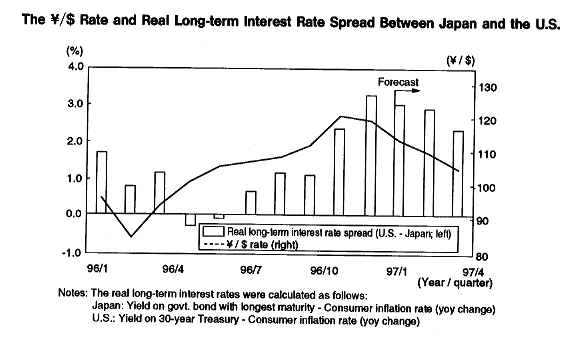
3. Stance of Monetary AuthoritiesIn the second half of fiscal 1997, both U.S. and Japanese monetary authorities are expected to shift their targeted exchange rate range toward a stronger yen due to Japan's economic recovery and large external surplus, and the U.S. economy's slowdown. However, the yen's appreciation will be stopped at around 100-105 yen to prevent the recovery from faltering.
4. Overseas Economies
(1) North America
In 1997, the North American economy will achieve moderate growth as the U.S. economy slows down. Canada will maintain its present pace and continue its expansion.
The U.S. economy, which has enjoyed strong growth, will slow down from 4.4 percent growth in the first half of 1997 to 2.3 percent in the second half. Since the fourth quarter of 1996, the economy’s growth had exceeded a sustainable pace. In the first quarter of 1997, concern of overheating surfaced as consumer spending grew at an annualized rate of 5.6 percent from the previous quarter, while real GDP grew 5.9 percent.
However, signs that the economy was slowing down appeared in the second quarter including sluggish retail sales. Although the economy should pick up again in the third quarter, its undertone thereafter will be one of slower growth. Consumer spending will slow down due to a lingering debt burden despite progress in debt adjustment, and to slower income growth. Capital investment growth will also slow down as earnings growth levels off, but will remain steady overall due to investment in information technology. As for net exports, the deficit will remain at its present level as the domestic economy’s slowdown is offset by Asia’s expanded demand for commercial jetliners and other factors.
Inflation remains stable despite an economic growth rate exceeding the potential growth rate of approximately 2 percent. However, inflationary pressure is gradually mounting against a backdrop of a tight labor market, and the inflation rate will tend to rise from late 1997 and into 1998. On March 25, the FRB raised the FF rate by 0.25 percent. Since then, its monetary policy has remained unchanged, although further rate hikes have been postponed due to the weakness of consumer spending and stability of prices. We predict that the inflation rate will edge up by the end of 1997, and that the present FF rate of 5.5 percent will be raised to 6 percent.
Canada’s economy is maintaining an expansionary undertone begun in the second half of 1996. In the first quarter of 1997, real GDP grew at an annualized rate of 3.4 percent over the previous quarter. Although consumer spending may not be sustainable due to low savings rates, net export growth will help the economy maintain its present pace and post 3.2 percent growth (over previous half, annualized) in the first half of 1997 and 3.1 percent in the second half. Inflation will remain stable because inflationary pressure from wages is minor, and labor productivity growth is strong.
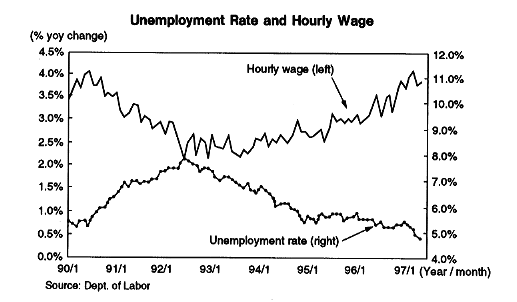
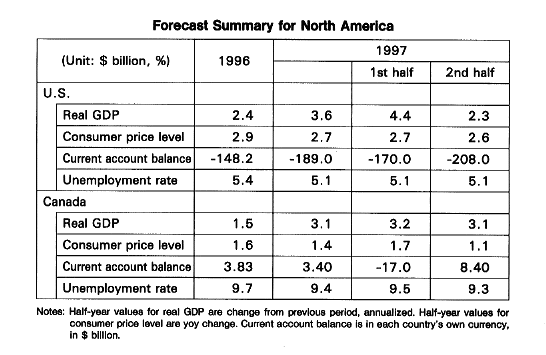
(2) Europe
1) Contrast Between the U.K. and the ContinentWhile the U.K. is cooling its slightly overheated economy centered around consumer spending with monetary tightening, persistent unemployment has become a social issue on the continent.
We predict that the U.K. economy’s growth rate will increase from 2.3 percent in1996 to 3.2 percent in 1997. In addition to an expansion in employment and income, consumer confidence has improved due to the election settling political uncertainty, and consumer spending will continue to lead the economy.
Although the strong sterling has recently been restraining inflation, the economy’s continued strong growth is causing inflationary pressure to mount. To prevent inflation from accelerating, the Bank of England will use its newly acquired authority to set policy rates and raise the base rate from 6.5 percent to 7.0 percent during 1997.
Meanwhile, Germany, France and other economies on the continent are not likely to recover in 1997, hampered as they are by rigid labor practices and fiscal austerity measures to satisfy monetary union requirements. Weak currencies will enable exports to continue leading these economies, as domestic demand cannot be expected to pay a significant role until at least the end of 1997. However, corporate investment will become increasingly active in anticipation of the monetary union.
The economies of Germany and France will recover only to the 2-2.5 percent range in 1997, up from the mid 1 percent range in 1996. Reflecting weak domestic demand, both economies will continue to have price stability, and policy rates will remain unchanged during the year.
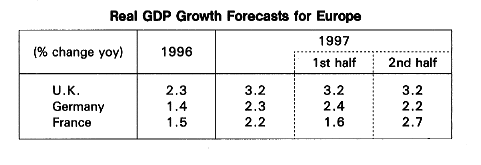
2) 1999 Monetary UnionIn predicting the course of Europe’s economy, the key factor is the Monetary Union. While this has been formally slated to begin in 1999, not all policies have been agreed on. For example, regarding the requirement for fiscal discipline, Germany seeks strict adherence to standards for participation, while France wants to shift the emphasis of policies away from rigid adherence to the promotion of economic growth and employment.
At the EU summit in June, the first after new governments were elected in the U.K. and France, a compromise was reached on this problem by adopting a resolution to focus on employment. With even Germany considered unable to meet the rigorous standards for participation, markets have already assumed the euro’s introduction in 1999 with the participation of many countries. Excluding the U.K. and other declared non-participants, Europe’s long-term interest rates are converging, and exchange rates against the DM remain extremely stable.
However, there is no assurance that disagreement will resurface between Germany, who favors a strong currency, and France, who has rejected the fiscal austerity requirements for monetary union. If a rift appears in the agreement from the June EU summit, Europe’s financial markets will react sensitively. Of keen interest will be the decision on EMU membership in May 1998 and Germany’s election in September 1998.
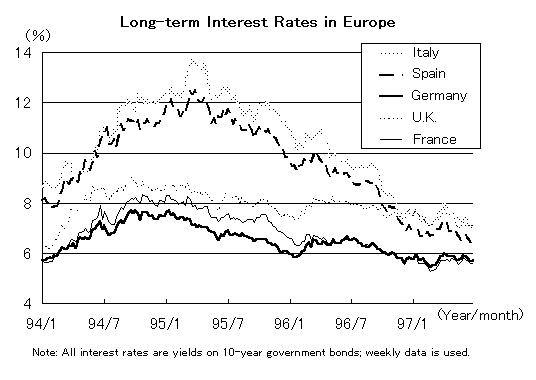
(3) Australia and Asia
1) AustraliaAfter bottoming out in late 1996, the Australian economy is recovering at a moderate pace as real GDP growth for 1997 declines to 2.7 percent. Due partly to monetary easing, residential investment is turning around and posting substantial growth, and capital investment remains strong, but consumer spending will be low due to delayed improvement in employment. With full-fledged recovery expected in 1998, inflation will maintain a stable undertone.

2) AsiaReal GDP growth for East Asia (China, NIEs, ASEAN) will edge down to 7.5 percent in 1997 (from 7.6 percent estimated for 1996). Growth rates for China, Taiwan, Hong Kong, and the Philippines will remain level or rise slightly, while other economies will continue to slow down due to sluggish exports and other factors. Presently, there are signs that exports will recover, including: (1) the bottoming out of semiconductor prices worldwide, and (2) strong economies among industrialized nations and China.
China
China’s real GDP growth rate will rise to 10.3 percent due to monetary easing since 1996 and a recovery in exports in 1997. Inflation will decline to 4.5 percent as consumer spending stays relatively stable.
NIEs
For Korea, exports will recover due to the weak won, but domestic demand will remain weak as Korea’s growth rate declines to 5.8 percent. Taiwan’s growth rate will edge up to 5.8 percent due to an economic recovery based on strong consumption and investment since the second half of 1996. Hong Kong’s growth rate will rise to 5.3 percent on the strength of domestic demand fueled by a recovery in the real estate market. While Singapore’s exports will recover in the second half of 1997, its growth rate will decline to 6.0 percent as the manufacturing and other sectors of domestic demand are sluggish.
ASEAN
The Philippine economy’s growth rate will rise to 6.2 percent. Thailand’s growth rate will decline to 5.6 percent due to slower exports and problems with non-performing loans; the baht also risks further decline. In Malaysia, growth will fall to 8.0 percent as the government bolsters its policy of restraining consumption and encouraging savings. Indonesia’s growth rate will decline to 7.6 percent due to an undertone of monetary tightening and the impact of public disturbances.
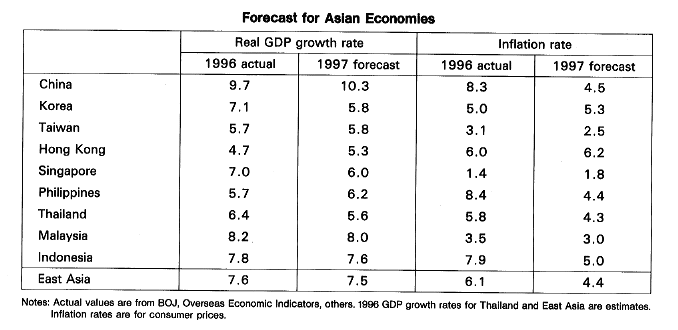
the Economic Research Dept.
Research field

















